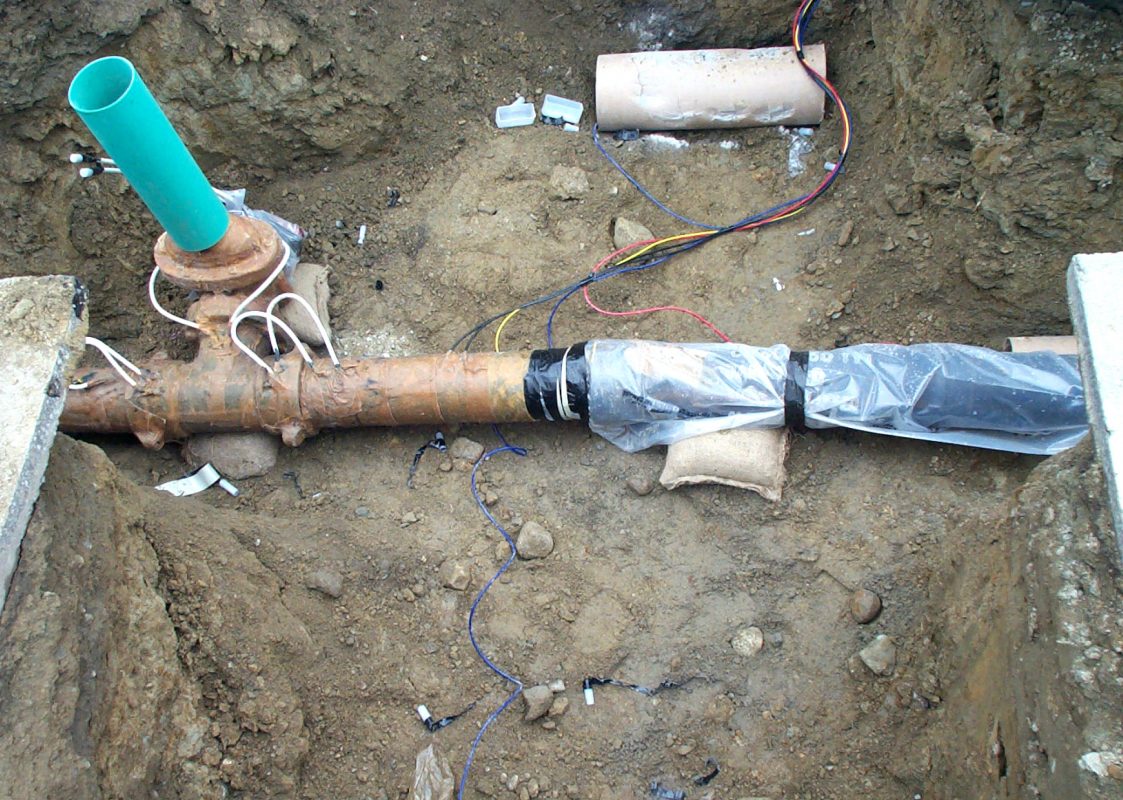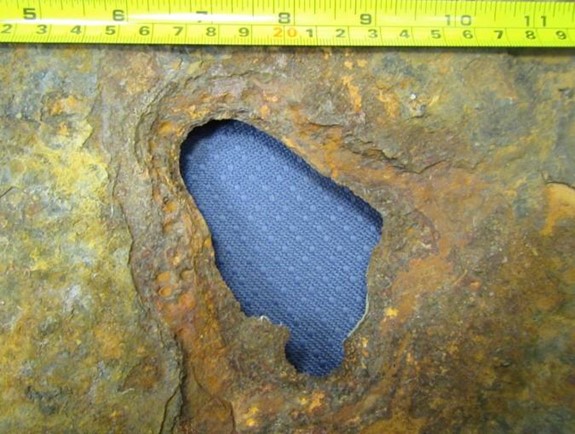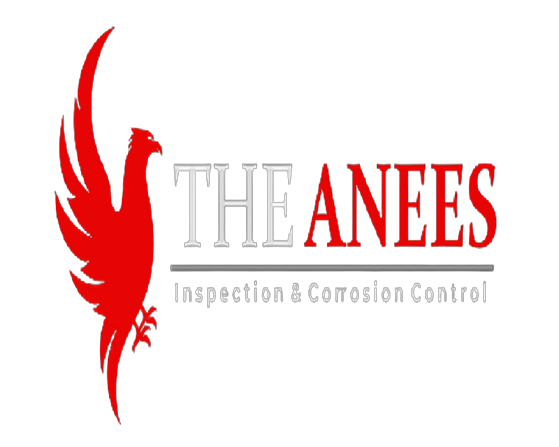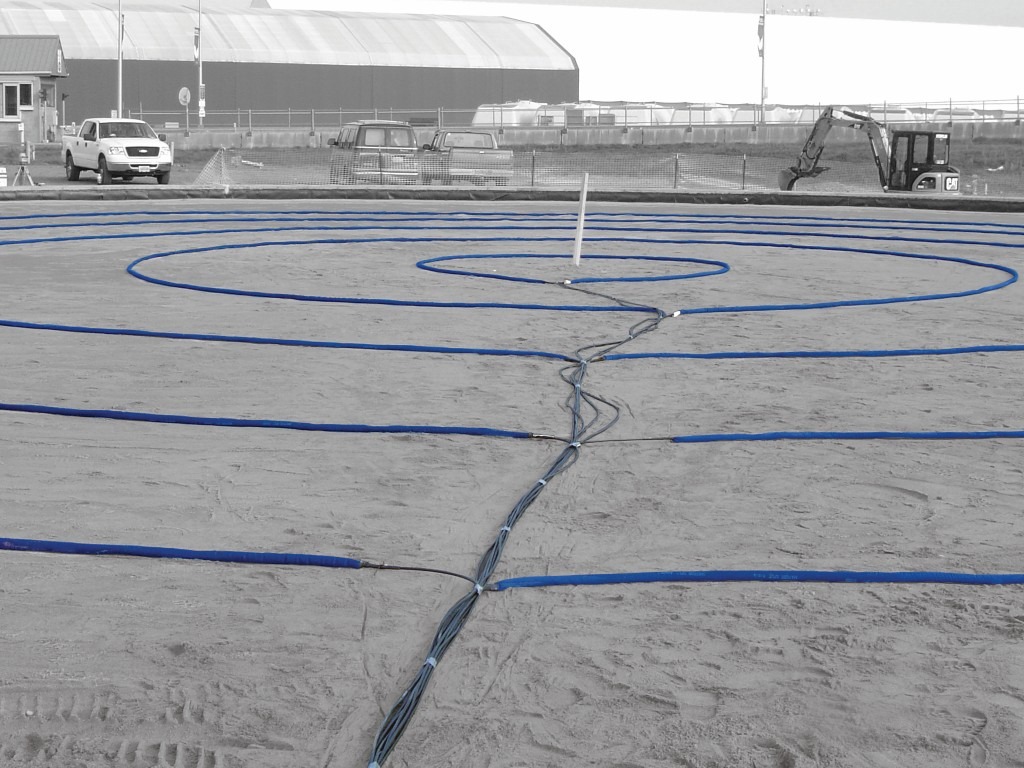Unless protective measures are taken, buried steel storage tanks, piping, and other metallic components of fuel storage systems corrode (rust) and leak product into the environment. Corrosion can attack the metal either over the entire surface of the metal (uniform corrosion) or in a small, localized area, creating a hole. Localized corrosion can perforate an unprotected tank in about 15 years and is the most common form of corrosion.
For corrosion to occur, four components must always be present: an electrolyte (water), an anode (a place on the metal where corrosion happens), a cathode (a place on the metal where corrosion does NOT happen), and an electrical pathway (usually the metal components of the storage system itself) between the anode and cathode. Corrosion always involves electricity—the movement of electrons from the anode to the cathode. This is handy because there are instruments that measure the movement of electrons (e.g., voltmeters and ammeters) that can tell us things about corrosion.
Steel underground storage system components must be protected against corrosion failure. This can be accomplished by using non-metallic components such as fiberglass, by coating the metal to isolate it from the electrolyte, or by using a technique called cathodic protection (CP). If properly installed and maintained, CP can prevent corrosion on the outside surfaces of steel tanks, piping, and other metallic storage-system components. It is the UST operator’s job to ensure that the CP system is properly maintained so that the UST system remains protected from corrosion.
CP only protects the outside surface of the metal that is in contact with the soil. It does not protect the inside surfaces. For this reason, it is very important to keep all water out of steel tanks. Water is an electrolyte and will promote corrosion. Petroleum products are not electrolytes, so corrosion on the inside of tanks is not a problem as long as there is NO WATER present.

How Does Cathodic Protection Prevent Corrosion?
Remember that one of the four elements necessary for corrosion to occur is a cathode—a place where metal does not corrode. To combat corrosion with cathodic protection, we must set up a situation where the tank and/or its piping become a cathode. This is accomplished by creating a flow of electrons onto the surface of the metal. The corrosion then happens at the place that is producing the electrons (the anode). The anode will deteriorate over time and will need to be replaced, but as long as the anode is providing enough electrons, your tank and/or piping will be a cathode and will not corrode. There are two techniques for creating this flow of electrons from the anode to the cathode: galvanic CP and impressed current CP.
Galvanic Cathodic Protection
It uses simple chemistry, much like a flashlight battery, to produce the flow of electrons. The anode is typically a piece of zinc or magnesium that is buried in the ground and connected to the tank or pipe using a copper wire as the electrical pathway. If you own a boat, you are probably familiar with galvanic CP because zinc anodes are often used to protect outboard motors, propellers, and other underwater metal components of boats. Most of the CP systems in Maine are galvanic systems.

Impressed Current CP
It uses standard 110-volt electricity from the power grid, just like the electricity that powers household lights and motors. The alternating current electricity from the power grid is first converted to direct current (like that from a battery) using a device called a rectifier. The direct current from the rectifier powers buried anodes that provide the electrons to protect the storage system.
How Do You Know IF Your Cathodic Protection CP System Is Working?
Because anodes are designed to wear out over time, it is important to be able to tell when it is time to replace them. Fortunately, determining whether a CP system is working is relatively easy to do. It does not require any excavation, just a few specialized tools—a reference cell and a voltmeter. The reference cell is a copper rod inside a special container that is placed on clean soil at ground level (not on concrete or asphalt). The voltmeter reads the voltage between the reference cell and the buried tank or piping. The voltage readings are usually negative, and a reading more negative than -0.85 volts is the standard for steel to be adequately protected against corrosion. For impressed current systems, the rectifier must be turned off to make this measurement.
This type of voltage measurement, often called a structure-to-soil potential, is required for both galvanic and impressed current CP systems and must be repeated each year. The measurements must be made by a Maine-certified tank installer or a tank inspector with special certification to test CP systems. This CP test is often included as part of your annual inspection. You must keep the test report that documents these measurements on file for at least 3 years.
Is There Anything Else You Must Do to Monitor Your CP System?
If you have a galvanic CP system, making sure that you have adequate structure-to-soil potential readings each year is all you have to do. If you have an impressed current system, you must have adequate structure-to-soil potential readings each year AND you must also check the status of the rectifier at least once a month. As an UST operator you can do this monthly reading yourself. Most rectifiers include meters that give you the voltage and amperage being produced by the rectifier. Each month, you simply write down the voltage and amperage numbers in a log that records the date, voltage reading, amperage reading, and your initials. You must keep this log sheet on file for at least 3 years after the last reading.
What should the rectifier readings be? The voltage and amperage readings on the rectifier will be different for each facility that has impressed current CP. The actual numbers are not important. It is important that the numbers do not change much over time. If the voltage or amperage readings change more than about 10% from what they were when the CP system was first installed, then it is likely that something has affected the system, and it needs to be checked out. The corrosion engineer who designed the system should be notified of the change immediately.

Steel is protected from corrosion when it has a voltage more negative than -0.85 volts when measured with a reference cell (e.g., a reading of -0.88 indicates that a tank is protected. A reading of -0.83 indicates that a tank is NOT protected and the CP system must be repaired.)
Voltage readings more positive than-0.85 (e.g., -0.84, -0.80) are FAILING tests.
Cathodic protection can only be tested by a
Certified Tank Installer
or
A Certified Tank Inspector approved as a CP Tester.
What Do You Do If Your CP Fails the Test?
If you have failed readings, you must do the following:
- First Failed Test – Your CP tester should conduct some troubleshooting procedures. These include being sure that the ground is thawed and moist and checking the electrical isolation and continuity of the CP system components. The CP tester should also know how to conduct tests to determine whether adding galvanic anodes will fix the problem or whether you should consider switching to an impressed current system. The CP tester may need to return with additional equipment to conduct these tests.
- Second Failed Test – Unless the problem is frozen soil, you should have your CP system retested within a week or two of the first test. If the readings are still not passing, you must have your CP system repaired or remove the tank or piping.
Conditions that Affect Structure-to-Soil Voltage
Age: Anodes get used up over time. Low voltage readings may indicate that anodes need to be replaced.
Weather: Dry or frozen soil can cause low voltage readings. Schedule your annual inspection for the spring when the soil is thawed and more likely to be wet.
Lack of Isolation – Other metal in contact with your tank or piping or electrical currents from large power sources (e.g., an arc welder) near the tank system can disrupt the electrical flow of the CP system and leave your tank or piping unprotected.
Reference: Maine.gov TankSmart™

